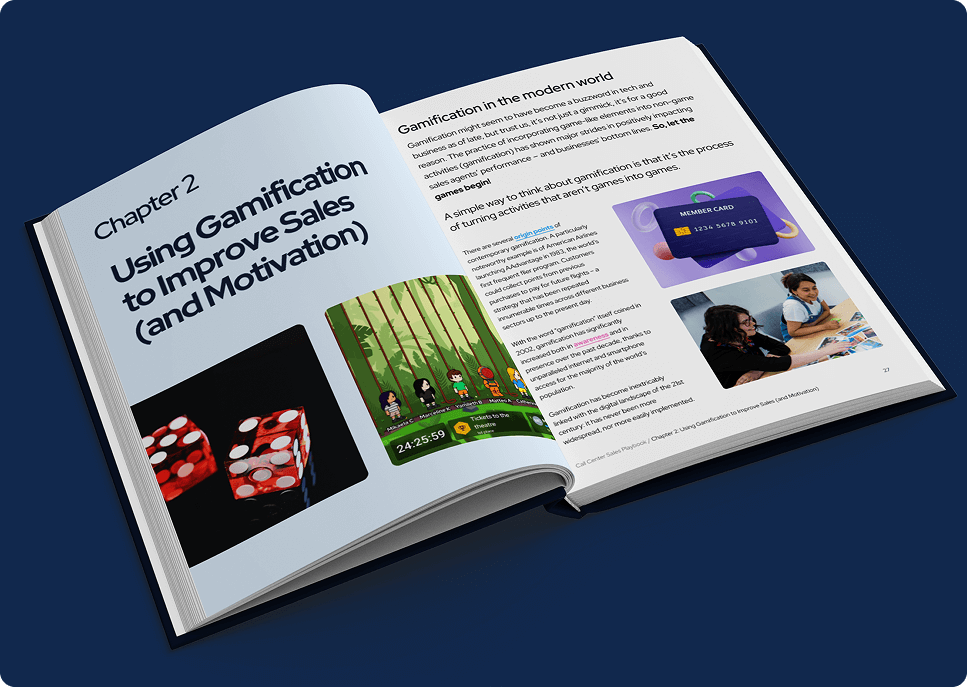Introduction
Gamification goes hand-in-hand with visualizing data in the contemporary office. The application of game-like components to non-game activities, gamification has tremendous potential to revolutionize your office culture through the employee motivation and engagement it promotes. In short: gamification makes work fun!
While Plecto offers several formats with which to gamify your workflow, creating an office gamification from scratch shouldn’t be something you do blindly. Rather, an effective gamification strategy requires knowledge who you’re designing games for. But how do you find this information?
In the same way your company has an ideal customer profile (ICP) for the product or service it offers, you should also have an “ideal gamer profile” for gamifying your call center operations. In other words, your gamification strategy should be optimized to best match your employees’ personalities and motivations.
Richard Bartle, a noted professor of game design at the University of Essex, developed a set of personality profiles based on how different types of individuals respond to, and interact with, each other when placed in game-like situations. Bartle’s four player types are described below:
🥇 Achievers: Highly focused on points and status, they enjoy displaying badges or other marks of achievement.
👏 Socializers: They practice collaboration with others to achieve a larger goal. Competition is of secondary importance.
🧭 Explorers: Primary motivation is discovering secrets and surprises. Not that concerned with points or competition.
☠️ Killers: Primary motivation is achieving a competitive thrill and winning at any cost. They want to see others lose.
In this blogpost, we’ll discuss each of the four player types in more depth, and how you can use knowledge of these player types to create a more efficient and effective office with a robust team culture. Let's dive in!
*Note: For each player type, "office applications" offered by Plecto are given in bold.

Achievers 🥇
Motivated by their desire to win points, level up, use tools and equipment, and obtain concrete results, Achievers fully immerse themselves within the game universe to experience all the game has to offer while, of course, coming out on top.
Though victory is the supreme goal, Achievers also pay great attention to completing quests, defeating challenges, and collecting items to bolster their gameplay. Serious gamers in every sense of the word, Achievers aren’t particularly numerous, estimated at about 10 percent of the population.
Office applications
Notifications, Badges, Contests (individual-focused), Leaderboards, Streaks, Sales Bingo, Dirty Santa, Reward Store

Socializers 👏
“Interaction” is the name of the game for Socializers. By far the most numerous of all player types, at about 80 percent of the population, Socializers value the relationships cultivated with other players during gameplay rather than winning outright or even achieving in-game goals.
Chatting with others, forming friendships, and collaborating on shared tasks are Socializers’ primary motivators. Because of the community-building focus that Socializers exemplify–and thanks to their sheer numbers–you can’t go wrong in incorporating a decidedly social or teambuilding aspect into your office gamification plan.
Office applications
Contests (team-focused), Sales Bingo, Reward Store

Explorers 🧭
Driven by a desire to discover the hidden nooks and crannies of the game universe, Explorers prefer to engage with their curiosity above everything else. Like Socializers, actually winning the game is a distant priority for Explorers. But like Achievers, they want to immerse themselves in the game-world and discover all it has to offer.
Games that have secret locations and Easter eggs to discover, or a significant backstory and engaging lore, tend to strongly pique Explorers’ interest. Perhaps a more introverted type than the others, Explorers comprise about 10 percent of the public.
Office applications
Sales Bingo, Reward Store

Killers ☠️
Finally….Killers. Comprising one percent or less of the population, Killers have a dramatic name that underscores their highly competitive nature. For Killers, winning isn’t enough–they actively want to see others lose. They obtain a competitive thrill through PvP (player-versus-player) combat, especially if this direct form of combat allows them to dominate others.
Ruthless in their persistence, Killers’ core drive is to outsmart and overpower others. While Killers’ gameplay instincts might appear antisocial, having a Killer or two around will give your gamification a decidedly competitive edge and can drive your teams forward to achieving their goals.
Office applications
Notifications, Badges, Contests (individual-focused), Leaderboards, Dirty Santa, Reward Store
Build your first dashboard.
Start your 14-day free trial today
How to use Bartle's player types
No type is better or worse than another at gameplay. Rather, the lesson to draw from Bartle’s types is that different things motivate different people.
Keep this in mind as you design a gamification strategy. Observe your agents to see what makes them tick. Are they spurred on my internal collaboration, or is there an intense competitive streak between them?
If it’s the former, your team is likely dominated by Socializers and Explorers. Your agents will benefit from seeing team goals visualized, so your gameplay should have a team-based rather than individual focus. That is, team members are encouraged to work together to accumulate points and meet KPI goals set out for them.
Human interaction and collaboration is the key driver for Socializers, while Explorers are driven by a desire to contribute to the team and discover other ways their teammates haven’t thought of to help achieve the collective target.
However, if your team is driven by intense interpersonal competition, it’s likely dominated by Achievers and Killers. Your employees will benefit from seeing individual goals visualized, as those who fall under these player types thrive off of winning and being recognized for their achievements.
When placed in situations where they are set to compete rather than cooperate, these employees will often fiercely battle it out to meet KPIs and targets, particularly in the sales department.
Knowledge of player types can also be helpful for determining which situations your employees will thrive in. While it’s undoubtedly advantageous to match your agents to situations and reward them based on their natural traits, player types can also be used to encourage personal growth in other settings. Throwing your agents “in the deep end” of unfamiliar scenarios will challenge them to use their established skill set and player type in novel ways.
How might a Socializer rack up as many calls as possible in a given period? How might a Killer learn to collaborate on a team project? You might be surprised at how well an employee adapts to a situation you believe requires a different response than how s/he would typically approach it.
Conclusion
Bartle’s player types aren’t necessarily ironclad laws. Even in individuals where one type is dominant, other types might be displayed to some extent.
But Bartle’s gamer taxonomy nonetheless reveals something important about how people interact with each other in a game-based context. With fundamentally different methods and mentalities of approaching gameplay, it’s crucial to both understand these individual paradigms as well as the effects these can have on your office culture.
Armed with this knowledge, you can design an exciting and engaging gamification setup that will boost motivation and improve performance for all your teams and employees.
Sounds exciting? Check out Plecto’s gamification features with our free 14-day trial!

Want to know more about the importance of gamification in the call center?
Check out Plecto’s newest FREE ebook, The Winning Formula for Selling More in the Modern Call Center. Download here!

JAMES NIILER
Content Specialist
An in-house content writer and specialist at Plecto, James brings an academic touch and journalistic flair to his marketing copy. Having worked and studied on both sides of the Atlantic, James is a great believer in the importance of communicating across cultures and industries. Catch his work here on the Plecto blog, or as a guest contributor on other B2B websites.



